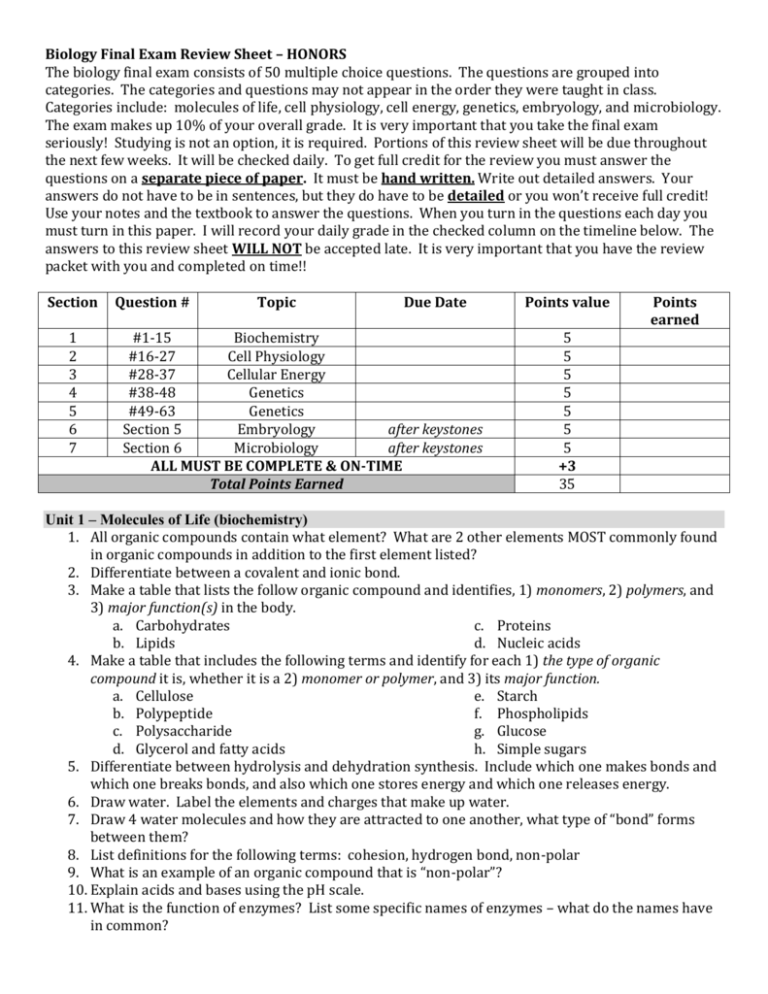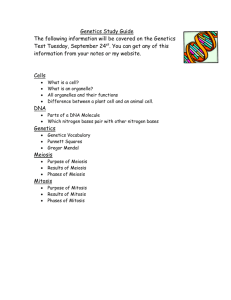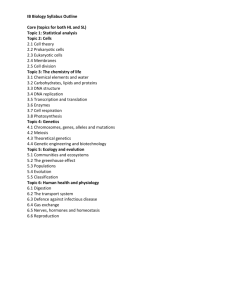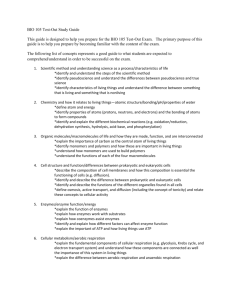Biology Final Exam Review Sheet – HONORS
advertisement

Biology Final Exam Review Sheet – HONORS The biology final exam consists of 50 multiple choice questions. The questions are grouped into categories. The categories and questions may not appear in the order they were taught in class. Categories include: molecules of life, cell physiology, cell energy, genetics, embryology, and microbiology. The exam makes up 10% of your overall grade. It is very important that you take the final exam seriously! Studying is not an option, it is required. Portions of this review sheet will be due throughout the next few weeks. It will be checked daily. To get full credit for the review you must answer the questions on a separate piece of paper. It must be hand written. Write out detailed answers. Your answers do not have to be in sentences, but they do have to be detailed or you won’t receive full credit! Use your notes and the textbook to answer the questions. When you turn in the questions each day you must turn in this paper. I will record your daily grade in the checked column on the timeline below. The answers to this review sheet WILL NOT be accepted late. It is very important that you have the review packet with you and completed on time!! Section 1 2 3 4 5 6 7 Question # Topic Due Date #1-15 Biochemistry #16-27 Cell Physiology #28-37 Cellular Energy #38-48 Genetics #49-63 Genetics Section 5 Embryology after keystones Section 6 Microbiology after keystones ALL MUST BE COMPLETE & ON-TIME Total Points Earned Points value Points earned 5 5 5 5 5 5 5 +3 35 Unit 1 – Molecules of Life (biochemistry) 1. All organic compounds contain what element? What are 2 other elements MOST commonly found in organic compounds in addition to the first element listed? 2. Differentiate between a covalent and ionic bond. 3. Make a table that lists the follow organic compound and identifies, 1) monomers, 2) polymers, and 3) major function(s) in the body. a. Carbohydrates c. Proteins b. Lipids d. Nucleic acids 4. Make a table that includes the following terms and identify for each 1) the type of organic compound it is, whether it is a 2) monomer or polymer, and 3) its major function. a. Cellulose e. Starch b. Polypeptide f. Phospholipids c. Polysaccharide g. Glucose d. Glycerol and fatty acids h. Simple sugars 5. Differentiate between hydrolysis and dehydration synthesis. Include which one makes bonds and which one breaks bonds, and also which one stores energy and which one releases energy. 6. Draw water. Label the elements and charges that make up water. 7. Draw 4 water molecules and how they are attracted to one another, what type of “bond” forms between them? 8. List definitions for the following terms: cohesion, hydrogen bond, non-polar 9. What is an example of an organic compound that is “non-polar”? 10. Explain acids and bases using the pH scale. 11. What is the function of enzymes? List some specific names of enzymes – what do the names have in common? 12. Define a catalyst. 13. What environmental factors influence enzyme activity? 14. How do changes in the environmental factors listed above impact the activity of the enzyme? 15. What is the difference between an element and a molecule? Which is larger in size? Unit 2: Cell Physiology 16. List the 3 components of cell theory. 17. Differentiate between prokaryotic and eukaryotic cells. Give an example of each. 18. What is the function of each of the following organelles? a. Nucleus d. Mitochondrion g. Golgi body b. Plasma Membrane e. Chloroplasts h. Vacuoles c. Ribosomes f. Lysosomes i. Cell wall **Be able to identify/label these organelles in a plant or animal cell. 19. What organelles listed in #18 are found in most prokaryotic cells? 20. What organelles are present in a plant cell that are absent in an animal cell? 21. What are the levels of organization from simplest to most complex? 22. Create a table comparing active and passive transport. Include the following information: a) what direction is the concentration gradient? b) Is energy required? c) what is the goal of this process? 23. Define the following terms and classify them as active or passive transport: a. diffusion d. endocytosis b. osmosis e. exocytosis c. facilitated diffusion 24. Draw the cell membrane. Label: phospholipid bilayer, protein, carbohydrate chain, and cholesterol. 25. Draw a phospholipid bilayer (include 8 phospholipids total) and label the hydrophilic and hydrophobic regions. Which area(s) would be exposed to water? 26. Draw an example and describe what would happen in cells of the following solutions: hypertonic, hypotonic, isotonic. a. What type of passive transport is occurring in these examples? b. What is moving in and out of the cell in each of these 3 scenarios? 27. What is the meaning of homeostasis? Unit 3 – Cell Energy (photosynthesis and respiration): 28. What types of organisms use photosynthesis? 29. Draw the structure of ATP and ADP and label the parts. What is the difference in structure between these two molecules? Which one is higher in energy? 30. What is a pigment? What is the primary pigment found in green plants? 31. Write the chemical equation for photosynthesis. Label products and reactants. 32. Write the chemical equation for cellular respiration. Label products and reactants. 33. Compare and contrast the chloroplast and mitochondrion. (What types of organisms contain each? Single or double membrane? What is its function – what process occurs here?) 34. Which process (photosynthesis or respiration) releases energy for cells? 35. What are the 2 steps of photosynthesis? Describe each. 36. What are the 3 steps of cellular respiration? Describe each. 37. Compare and contrast aerobic and anaerobic respiration (fermentation). a. What are the 2 types of fermentation? b. How much ATP is produced by each? Unit 4 – Genetics (includes information from: cell division, DNA & protein synthesis, and genetics unit) 38. Describe the shape and composition of a DNA molecule. 39. What is the function of DNA? 40. What is the structure of a nucleotide? 41. What are the complementary base pair rules for DNA to DNA? How are complementary bases bonded? 42. Compare and contrast DNA and RNA. 43. What is the function of mRNA, tRNA and rRNA? 44. What is a codon? What does it code for? How many letters make up each codon? 45. If you were given the following mRNA sequence (UUC GUU GGA ACC), what would be the amino acid sequence and DNA template? (use the genetic code provided here) 46. What is the difference between a gene and chromosome mutation? 47. Define and illustrate a point and frameshift mutation. a. How many codons change in a point mutation? In a frameshift mutation? 48. Describe transcription and translation. Where does each step occur? 49. Summarize the events of the cell cycle (Interphase (G1, S, G2), Mitosis, Cytokinesis). 50. Summarize the events of the stages of mitosis (prophase, metaphase, anaphase, telophase) 51. What is the difference between sexual and asexual reproduction? a. Which of these processes requires meiosis? b. What is a benefit of this type of reproduction? 52. What is the difference between homologous chromosomes and sister chromatids? 53. What is the difference between diploid and haploid cells? Classify somatic cells and gametes as each of these. 54. If a skin cell of an animal had 52 chromosomes, how many chromosomes would be in an egg cell from this species? 55. What are the differences between Meiosis I and Meiosis II with respect to the alignment of the homologous chromosomes and sister chromatids? Explain tetrads. 56. What is a karyotype? How can you tell a female from a male? 57. What is nondisjunction? a. What is another name for down syndrome? Describe what the karyotype would look like. 58. Compare and contrast mitosis and meiosis. a. Include general drawings of each type of cell division using 4 chromosomes. b. What must occur prior to the cells dividing? c. If a cell starts with 50 chromosomes, how many chromosomes would there be after mitosis? After meiosis? 59. Define the following terms: a. Genotype c. Homozygous e. Dominant b. Phenotype d. Heterozygous f. Recessive 60. How are the following words related? DNA, gene, RNA, protein, trait 61. What is a Punnett Square & what does it show? 62. Complete the following genetics crosses: a. Monohybrid Heterozygote Parents (Tt x Tt) b. Determine the parents genotypes and perform a punnett square for the following problem. Brown hair is dominant to blond. Two parents are mated one with blonde hair and one with brown, and some of their children end up with blonde and some with brown. c. Dihybrid Heterozygote Parents (TtYy x TtYy) d. A colorblind male with a female carrier. (Hint: colorblindness is x linked recessive) e. A Red snapdragon with a pink snapdragon. (Hint: RR = red, rr = white, Rr = pink is the heterozygote showing incomplete dominance.) 63. Analyze the following pedigrees. Determine if the type of inheritance is dominant, recessive, or sex-linked based on the people that inherit a certain trait. A C B D Unit 5 – Embryology 64. Compare oogenesis and spermatogenesis. a. Sketch and describe the function of the sperm cell. 65. Place the following words in chronological order & then define them: a. Fertilization e. Implantation i. Embryo b. Blastula f. Morula j. Fetus c. Gastrula g. Cleavage d. Zygote h. Gastrulation 66. What are stem cells? 67. What is differentiation? 68. What is the role of the placenta? 69. What are the germ layers? When do they arise and what do they produce? 70. What is the first system to develop in a growing embryo? Unit 6 – Microbiology 71. Compare and contrast bacteria and viruses. What do they have in common? What are differences between them? 72. What are the three different shapes of bacteria? 73. How do bacteria reproduce? 74. What is the difference between facultative anaerobes and obligate aerobes? 75. How do some bacteria help humans? 76. What are antibiotics? What are they used to treat? 77. What is antibiotic resistance? How/why does it occur? 78. Why do you have to get some vaccines every year instead of only once? 79. Describe the structure of a virus. What are the 2 main parts? 80. Compare the lytic and lysogenic cycles of viral infection. 81. What is a retrovirus?







